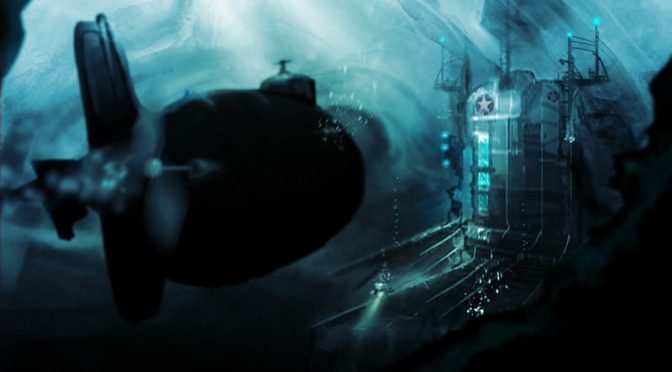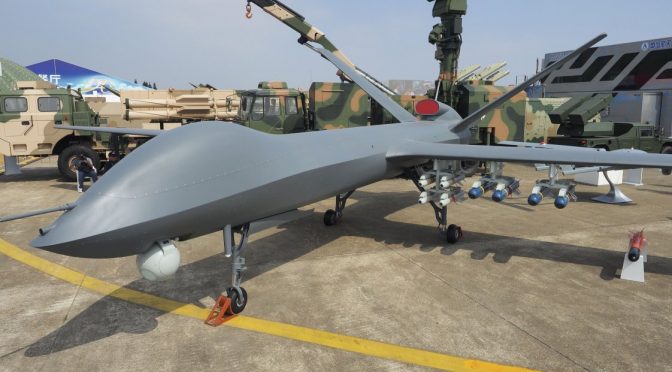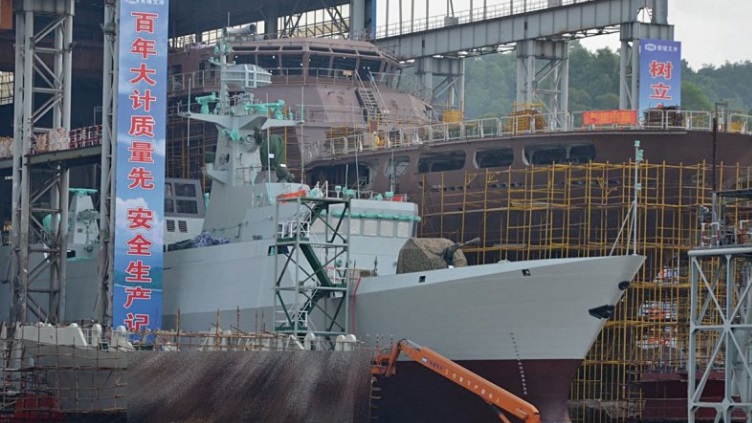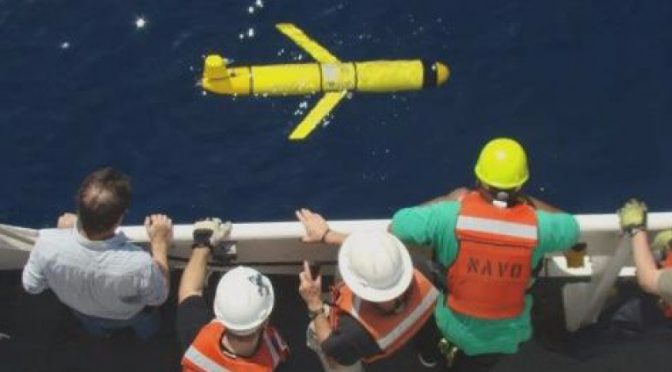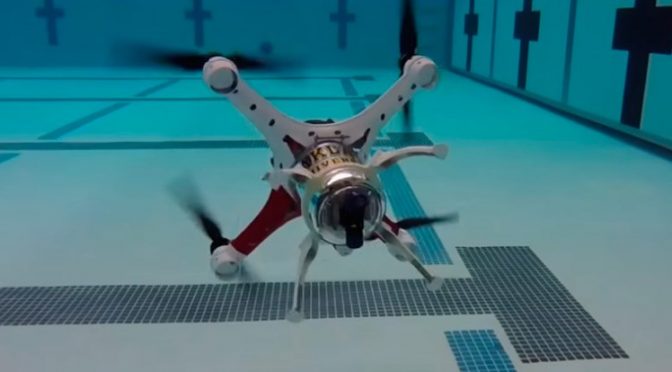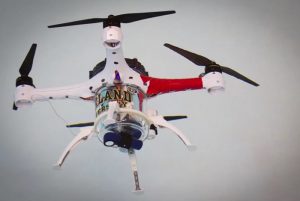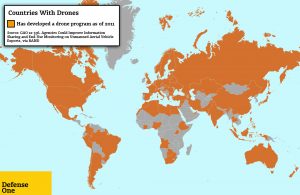By David R. Strachan
TOP SECRET/NOFORN
The following classified interview is being conducted per the joint NHHC/USNI Oral History Project on Autonomous Warfare. This is the first of an eight-part series with Admiral Jeremy B. Lacy, USN (Ret), considered by many to be the father of autonomous undersea warfare, where we discuss the development of the Atom-class microsubmarine, and its role in the first combat engagement of the autonomous era, the Battle of Locust Point.
November 17, 2033
Annapolis, Maryland
Interviewer: Lt. Cmdr. Hailey J. Dowd, USN
The last twenty-five years have witnessed extraordinary developments in naval warfare. Ever smaller, smarter, more lethal vehicles have revolutionized the way navies fight, and the way nations project power beyond their borders. Historians agree that the genesis of this “micronaval revolution” can be traced to the year 2016, when a disabled Russian Istina-class microsubmarine was recovered off the coast of Cape Charles, Virginia. The Chesapeake Bay Incident, as it became known, was a harbinger of things to come, for just ten weeks later, as crowds descended on Baltimore Harbor for Fleet Week and the commissioning of the U.S. Navy’s newest destroyer, USS Zumwalt (DDG 1000), Russian and U.S. microsubmarines would square off just beneath the surface in what would be the first combat engagement of the autonomous era, the Battle of Locust Point.
Historians also agree that the micronaval revolution can be traced to a single individual, an individual whose name, like Hyman Rickover, is virtually synonymous with the bold thinking that has come to define the modern U.S. Navy.
Admiral Jeremy Baynes Lacy, USN (ret.) graduated from the United States Naval Academy in 1989, earning a Bachelor of Science in Mechanical Engineering. He served at sea aboard the USS Pennsylvania (SSBN 735), USS Henry M. Jackson (SSBN 730), USS Springfield (SSN 761), and the USS Pogy (SSN 647), deploying to the North Atlantic, Arctic, and Western Pacific, as well as conducting numerous strategic patrols. Ashore, Lacy earned a Masters Degree from the Naval Postgraduate School in Naval/Mechanical Engineering, and served as Major Program Manager for Undersea Project 7, the Atom-class microsubmarine program. Following his work on the Atom-class, he established and commanded Strikepod Group (COMPODGRU) 1, eventually serving as Commander, Strikepod Forces, Atlantic (COMPODLANT). His personal decorations include the Distinguished Service Medal, the Legion of Merit (three awards), the Meritorious Service Medal (two awards), the Joint Service Commendation Medal, the Navy and Marine Corps Commendation Medal (five awards), and Navy and Marine Corps Achievement Medal (two awards), in addition to numerous unit and campaign awards.
Admiral Lacy is currently enjoying his “retirement” as the Corbin A. McNeill Endowed Chair in Naval Engineering at the United States Naval Academy. He was interviewed at his home in Annapolis, Maryland.
Would you tell us a little of your background? How did you end up in the Navy?
I was born and raised in the rural New Jersey hamlet of Port Murray, nestled among cornfields and cow pastures many people can’t believe exist the Garden State. My mother was a secretary at the local elementary school, and my father managed a printing plant just outside New York City. He grew up dirt poor on a farm in New Hampshire without a whole lot of options, so he enlisted in the Navy the day after he graduated from high school. After basic, he ended up in crypto school in California, then a Naval Security Group detachment in Turkey where he eavesdropped on Soviet communications. When I was little he used to make these veiled references here and there to his time in the service, but he never elaborated on anything. He took his secrecy oath very seriously, and it wasn’t until the mid 80s, when I was a curious teenager, that he felt comfortable opening up about what he did. I was totally captivated by the stories he would tell, and the meaning that the work gave him. As luck would have it, I was a pretty good student, and managed to get accepted to the Academy. Fast forward four years and I’ve got a degree in mechanical engineering, and five years of submarine service waiting for me.
Why did you choose submarines?
Never in a million years did I expect to end up choosing submarines. It was the time of Top Gun, and boy I was gonna fly jets! But during my summer service orientation I went for a cruise on the Nebraska, and that was it. I was hooked, and fifteen months later I’m on the Pennsylvania for my junior tour.
Would you say it was the submarine service that spurred your interest in unmanned vehicles?
Oh, definitely. When I was on the Pogy we worked with some very early prototypes sent up from [Naval Undersea Warfare Center] Newport for arctic testing. Nothing too sexy – ocean survey, bathymetry. But I guess at that time I was intrigued with the idea, and started imagining the possibilities, the implications. What if these things could think for themselves? What if they were weaponized? And what if the bad guys had them? After my tour on Pogy, I ended up at the Naval Postgraduate School working on my masters, and actually wrote my thesis on UUVs – a survey of current architecture, an examination of future technologies and how these could be leveraged for unmanned systems, and how UUVs could be integrated into fleet operations.
Legend has it DOD wanted to classify it.
[Laughs] Well, not really. It was nothing more than a skillful integration of open sources, some analysis, and extrapolation. It did manage to attract some interest, though.
From ONR? DARPA?
Well, actually it was the folks at Newport who reached out to me initially. My advisor at NPS was friendly with the CO there, and at the time – around early 1999 – they were working with APL, SPAWAR, and some other folks on crafting the Navy’s UUV master plan. So they called me up, asked if I’d like to come aboard, and next thing I know I’m on a plane to Rhode Island.
What was your contribution to the 2000 UUV Master Plan?
Well, by the time I entered on duty, the bulk of the heavy lifting was pretty much complete. But I did manage to contribute some perspective on the vision, CONOPS (especially in ASW), as well as technology and engineering issues. But where I think I added the most value was regarding the feasibility of the SWARM [Shallow Water Autonomous Reconnaissance Modules] concept – the idea of utilizing large numbers of small AUVs to create a dynamic, autonomous sensor grid for wide area mine countermeasures.
Was the SWARM concept a precursor to the Strikepod?
Conceptually, yes. It was an early articulation of an undersea battle group, the idea of numerous autonomous vehicles cooperating together to complete a mission. But while the idea was entirely feasible, I felt that SWARM was rather narrow in its scope. As an MCM platform, I suppose it made sense, with scores of small, relatively inexpensive nodes spread across hundreds of square miles, air dropped from B-2s or Hornets. But what we needed was an entirely new class of vehicle that was flexible, adaptive, and capable of carrying out multiple missions, whether in networks of two or two thousand. So, then, I guess you could say that SWARM inspired both Strikepods and the Atom-class submarine, but for different reasons.
Can you talk about how the Atom-class program originated, and how the Strikepod concept evolved?
I’d been having discussions with some of the Newport and MIT folks while working on the Master Plan, and we were all pretty much in agreement on the core elements of a UUV pod structure – connectivity, redundancy and expendability. We were also in agreement that small is beautiful, if you will, but all of the work on miniaturization was being done in the universities. Long story short, not only did ONR find the funding, but agreed to bring the university people on board, and next thing we have a lovely, windowless compartment in the basement of the Navy Lab. And we had a nice, nondescript name: Undersea Project 7.
It was an exciting time, and it was a genuine privilege working with some of the brightest minds around, people who could have easily been making five times their salaries at Google, or JP Morgan.
The technology was complex, and the work could be pretty tedious. Lots of highs and lows – two steps forward one step back. For some of the top brass it was hard to justify the expense, pouring all that money into a system that seemed unnecessarily complicated, and, for them, pure science fiction. Do we really need roaming schools of killer fish? Don’t forget, these were guys who came from the era of SOSUS. But that’s what we were offering – and more. A smart SOSUS that could be deployed anywhere, at any time.
We envisioned three variants – one for command & control, or what we called the Rogue, one for navigation and communications, which we called the Relay, and a third that could physically attach itself to vessels, mines, infrastructure. This we called the Remora. Together they could be organized in networks of any size, undersea strike groups capable of communicating with each other and, via the Relay, surface assets and ashore bases.
The Atom-class was under development for nearly fifteen years. Were you at all aware of what was happening with adversary developments, and did that play a role in the design?
Absolutely, and somewhat. Over time, I became increasingly involved with the intelligence side of things – collection guidance, and analysis. There came a point where I was ping-ponging pretty regularly between Carderock and Suitland, especially by the late 2000s when we were really stepping up our efforts. We were well aware of Chinese interest in unmanned systems, and around 2010 we started receiving reports about the Shāyú program. We were also keeping close tabs on some tech transfer between North Korea and Iran, something reminiscent of their Yono and Ghadir cooperation. There was a real sense of urgency, that we needed to be out-innovating and out-classing our adversaries if we were going to stay ahead of the curve. But we believed strongly in the Atom and Strikepods, and while it was important to know what the other guys were up to, we didn’t let it distract us from our own vision.
The most intriguing stuff was the HUMINT coming out of Rubin [Central Design Bureau for Marine Engineering] – concerning a Project S3, or “Istina” – references to unmanned systems, miniaturization, and a breakthrough in energy production. And then there were reports of Russian vessels showing up unexpectedly during our boomer patrols. They seemed to just know where we were. The counterintelligence guys were in overdrive – this was eerily familiar to the red flag that plagued Richard Haver before the Walker ring was exposed. So we couldn’t just stand there and scratch our heads. But everything checked out internally. So, if there was no security breach, then, how could they know?
So, I started compiling data, and mapped it all out. CIA and DIA both believed it could be evidence of a non-acoustic sensor of some kind, and while this was certainly plausible, the evidence was mostly hearsay. We had imagery of SOKS sensors, and journal articles, and public statements by high ranking officials, but no hard data to substantiate the existence of a viable, working platform. We were, however, receiving quality product on the Istina program that suggested the Russians had developed some kind of miniaturized naval platform capable of lurking silently off Groton or King’s Bay, then trailing our boats to expose their positions to the Russian Fleet.
But you couldn’t sell it?
[Laughs] Well, no, which, admittedly, was pretty frustrating. But something that gets lost in all the scandals and the slanted reporting is the commitment to analytic rigor that permeates the intelligence community. These folks understand that their work has a direct impact not only on U.S. policy, but ultimately on human lives. The difference between right and wrong can mean the difference between life and death, and they carry that burden every day. So, no, I couldn’t sell it. And it was back to the drawing board.
And then Cape Charles happened.
And then Cape Charles happened.
Can you tell us about that day?
I remember it like it was yesterday. It was a Saturday morning, one of those heavy, dewy August mornings in D.C. I was out getting in my run before the heat of the day, when I get a call from Chandra [Reddy, the ONI liaison for Undersea Project 7]. He tells me I need to come in to the office. We were working weekends pretty regularly, but I’d blocked out that day for a round of golf with my dad. I kindly remind him of this, and all he says is, “Jay – we’ve got something.” An hour later I’m on an SH-60 out of Andrews with Chandra and four engineers from S&T, tracking the Potomac out to the Bay.
They briefed me enroute. Apparently the Coast Guard in Cape Charles, Virginia got a call around 7:30 that morning from a fisherman about a mile off the coast who said he came across something that “looked military.” They send out an RB-M, and bring back what they believe is a U.S. Navy prototype submersible. They phone it in, and ninety minutes later we’re putting down on a grassy airfield in the middle of nowhere, where we’re greeted by an earnest seaman recruit who proceeds to leadfoot it all the way to the station.
It was being kept in a back room, sitting on a table under a blue tarp. When I first saw it, I thought it was just a radio-controlled sub, like someone’s weekend garage project had gone astray. It was basically a miniaturized Oscar II, maybe six or seven feet long, which I suppose shouldn’t be surprising, since the Oscar was built for capacity, and why go to the trouble of designing and developing a whole new hull form when you can just miniaturize one that’s already in the inventory?
We didn’t know how long it had been disabled, or if the Russians were even aware. We did know that the [Vishnya-class intelligence ship] Leonov had been lurking offshore, and there were a couple of fishing boats we were keeping an eye on near Norfolk, but for all we knew the handlers were right nearby, somewhere on shore. We had to assume they would come looking, so we had to act quickly.
We cracked it open and took a look right there on the table. The guys from S&T were like pathologists, very careful and thorough. One of them had a video camera, which I eventually realized was patched in to the White House Situation Room.
I don’t think I need to tell you that the intelligence value was immeasurable, a holy grail. It confirmed, of course, what I’d been speculating all along, but it also showed us just how far along the Russians were. The propulsion system alone was a quantum leap for them, and was very similar to what we had been developing for the Atom.
Too similar?
I’d say strikingly similar. Maybe alarmingly so. But there was so much information floating around in the public domain – academia, scientific journals – so much private sector R&D going on, the design could have originated anywhere. For sure there was plenty for the counterintelligence guys to lose sleep over, but at that moment we had bigger fish to fry.
Did you bring it back to Washington for further analysis?
Well, actually, no.
You see, during the autopsy, one of the tech guys notices something – a small explosive charge right against the hull, wired to the CPU. The damn thing had an autodestruct! It was right out of Mission Impossible, but it obviously had failed to activate. We’d been toying with just such an idea for the Atom-class – a small blast to punch a hole in the hull and allow it to disappear into the depths, then ping like a black box for eventual retrieval.
Chandra’s on the secure phone, presumably with the Situation Room, when he turns to me, pointing at the Istina. “They want us to blow it,” he says. “They want us to put it back.” Immediately I think – are they crazy? This is the biggest intelligence haul since K-129, and they want to just dump it? But then I realize – of course! The Bay is shallow enough that if the Russians come calling, they will expect to find it, and if they can’t, they’ll have to assume we did. We needed them to believe we were clueless, so we had to let them find it. That way they’d never know what we knew.
So we closed it up, drove it back out into the Bay, and scuttled it.
Was it then that the President authorized Operation Robust Probe?
The biggest question on everyone’s mind was: Is this an isolated penetration, or is it part of a larger operation? Prudence required that we take action to sanitize the Bay, so yes, Robust Probe was ordered, and the Navy immediately mobilized.
But as urgent as the situation was, there was also a need for discretion. We couldn’t exactly fill the Chesapeake Bay with destroyers. Even an increased presence of Coast Guard or small patrol craft would likely not go unnoticed, at least by the Russians. So, within hours the Navy had cobbled together a flotilla of private watercraft manned by cleared contractors and sailors in civies. They fanned out across the Bay, banging away with dipping sonar, fish finders, and whatever they could use.
Fortunately, we’d been putting Alpha, the first operational Strikepod, through its paces, and had been having a lot of success. So we fast-tracked sea trials, put a crew together, rigged up a mobile command post – the very first Strikepod Command – in what looks like a plain T.V. news van, and we’re in business.
Within twenty-four hours Alpha had detected another Istina lurking just off Thomas Point Light. It was an odd mixture jubilation – knowing that the Atom-class was a success – and dread, the weight of knowing of what was at hand, that the Russians had not only designed, developed and deployed a sophisticated micro AUV, but they were using it to brazenly violate our territorial waters.
Was there any other reaction from the White House?
The President immediately convened the National Security Council, and, yes, yours truly was ordered to attend and provide the briefing. He was not happy. How did we not see this coming? I explained how we were aware of Russian efforts, but that our coverage had been spotty. And there were no indications that the Russians were on the brink of deploying a new vehicle to the fleet, much less inserting it into U.S. territorial waters.
I remember how surreal it felt, sitting there in the Situation Room, the looks on the faces around me.
Fear?
Not fear. More like a mixture of deep concern and disbelief as if no one could wrap his head around the fact that this was actually happening. And I think everyone in that room knew that things were about to change, that all of our theorizing, prognosticating, and preparing for the future of naval warfare was coming to a head. The future had arrived, right in our back yard.
The prevailing opinion in the room was that we should move immediately to destroy it and contact the Russian government. The guys from CIA made a compelling argument for restraint – one with which I concurred – that this was more an opportunity than a threat. There was no reason to believe this was Russia’s opening move against the United States, and that if anything it was the latest example of resurgent Russian bravado and Putin’s longing for the Cold War days. This was an opportunity to gather as much intelligence as possible on a new foreign weapons platform. But there was also concern that, if weaponized, the Istinas could be used to stage a terror attack and sow further insecurity and political unrest in the United States. In the end, though, we managed to convince the President to hold off, but if at any point it was determined that there existed a threat to life or property, we would have to destroy it.
Did you personally have any theories as to its intentions?
Not many. There was Aberdeen [Proving Ground]. Theoretically an Istina could get in close enough to extract some SIGINT or MASINT, depending on the vehicle’s sensor capabilities. But who really knew? Maybe the Russians were just interested in ship spotting, or counting crabs.
And then it just kind of hit me. It was September – the following month was Fleet Week in Baltimore. The Navy would be showcasing its wares –warships, the Blues – which normally wouldn’t be such a big deal, except there was something else that year.
Zumwalt?
Exactly. Zumwalt was on the agenda that year for commissioning. She’d be sailing up the Bay, and then docked for several days at Locust Point. We weren’t concerned with an Istina attacking Zumwalt, per se, but we knew that there was much to be had intelligence-wise. And while we had no desire to enable a Russian intelligence operation, we also wanted to collect as much as possible of our own.
When we examined the Istina in Cape Charles, we didn’t discover a warhead of any kind, so we assumed any others wouldn’t be weaponized either. And even if they were, it was unlikely that a single Istina could inflict any meaningful damage on an armored warship, unless the Russians had managed to develop a super compact, high yielding explosive, but there was no intelligence indicating such. Perhaps a group of Istinas detonating simultaneously could cause a problem, enough to raise some eyebrows or even provoke a crisis, but it would take dozens to equal the yield of even a single torpedo.
It was a delicate, rapidly unfolding situation that was unlike anything we’d ever experienced in the modern era. Of course, we’d ventured into Soviet waters in manned submarines during the Cold War, at great risk to both human life and the delicate balance that defined the Cold War. But had Parche or Halibut been detected or attacked and sunk during Ivy Bells, it would have provoked a political crisis that may well have triggered World War III. Were the stakes just as high now? It was anyone’s guess.
Were you able to deploy additional Strikepods?
Yes. Alpha had been working like a charm, but then abruptly it loses contact with the Istina as it moves under a passing tanker, which was of course disappointing, but not entirely unexpected. In the meantime, we’d deployed two more six-ship Strikepods – Beta to cover the central Bay, and Gamma the southern region. It was a lot of territory to cover, but that constituted the sum total of our Atom-class fleet at the time. There were eight currently in various stages of production, but it would be at least a day or two before we could deploy them.
Pretty soon we get word that Gamma has detected something down near Bloodworth Island. At first we figured we’d reacquired the original, but an analysis of the acoustic data revealed that it was actually a new vehicle. It was alarming, for sure, knowing that there were now at least two Russian microsubmarines lurking in the Chesapeake Bay.
We tracked it for about two days, and then Beta manages to reacquire Istina number one. About twelve hours later, Alpha detects not one, but two more right at the mouth of the Patapsco River. That’s when everyone’s hackles went up. This was no longer a counterintelligence operation.
Operation Robust Probe becomes Robust Purge?
Correct. Once we realized that we were dealing with at least four Istinas in the Bay, and they were lingering in Zumwalt’s path, the time for just being sneaky was over. We needed to at the very least disrupt, if not outright destroy them.
By now the eight new Atoms have come off the line, so we fit them each with a makeshift warhead of C4, designate them Remoras, and deploy them immediately – four for Alpha, which was now tracking two separate targets, and two each for Beta and Gamma. They would only be employed if we felt that there was an immediate threat to life or property.
In the meantime, Zumwalt, Leyte Gulf, and Jason Dunham, and the other ships arrive, and as they transit the Bay, the Istinas take up position about 500 meters astern. Once the ships turn into the Patapsco, though, they back off and assume a position just outside the mouth of the river. They linger there for about twelve hours, until we get a burst from Alpha: One of the Istinas is headed up river.
So now we have a decision to make. Alpha is tracking two separate vehicles. Do we order Alpha to pursue, and break off contact with one of them? Turns out Sea Rays and Boston Whalers aren’t particularly effective ASW platforms, and Strikepods Beta and Gamma were both busy with their own tracks, well to the south, too far away to assist Alpha in time.
Then one of our brilliant engineers suggests splitting Alpha pod. We could repurpose one of the Remoras as a Rogue, and assign it an armed Remora and a Relay for coms. The engineers get on it, and in about fifteen minutes a small splinter pod breaks off and starts trailing the Istina up the Patapsco. Things get increasingly tense as it nears the Key Bridge, and we decide that if the Istina begins moving toward the bridge supports, we would have no choice but to destroy it.
After a few anxious moments it passes under the bridge without incident, and continues on a path toward Locust Point, where the warships are docked. Word comes down from the Sit Room: The Istinas now present a clear and present danger, so immediately we order the splinter pod to attack. A minute later a Remora detonates about five meters below the surface, and we watch as it and the Istina disappear from the tactical display. Beta and Gamma attack as well, sending their respective contacts, as well as two Remoras, to the bottom of the Bay.
And just like that it was over?
It was over.
The Strikepods and surface vessels continued to prosecute Robust Purge until Zumwalt and the other ships made it safely to the Atlantic. By all accounts, Baltimore Fleet Week, including the commissioning of the Navy’s newest destroyer, came off without a hitch. No one had any idea that the first decisive battle of a new era in naval warfare had just occurred within throwing distance of Fort McHenry.
What were the takeaways?
Well, we had terabytes of data to analyze, of course, but perhaps even more importantly, there were myriad political, security, and even philosophical questions to consider. What exactly were AUVs? Were they vessels? Weapons? In a way they were like spies, but rather than round them up and expel them, or put them in jail, we’d have to disrupt them, or even kill them.
Perhaps the biggest takeaway, though, was the realization that a new form of conflict was dawning. Submarines had of course always been characterized by stealth and secrecy, and had engaged in high risk cat-and-mouse games in order to stay ahead of the adversary. But now that submarines were unmanned, and, like their stealthy manned cousins, operated far from the prying eyes of the public, a kind of limited war was now possible, a war with little or no risk of escalation, or political fallout, and most importantly, no loss of human life. A war characterized by secrecy, anonymity, and non-attribution.
In other words, as we sit here today in my living room, in the year 2033, with the benefit of hindsight, our vision of AUVs as merely an extension of the Fleet’s eyes and ears was really rather primitive.
And only the beginning of the story.
[End Part I]
David R. Strachan is a writer living in Silver Spring, MD. His website, Strikepod Systems, explores the emergence of unmanned undersea warfare via real-time speculative fiction. Contact him at [email protected].
Featured Image: Arctic Sub Base by Jon Gibbons (via Deviant Art)

